Lunch holds the power to refuel the body and sharpen the mind for the rest of the day. However, many people ask how many calories a lunch should have to stay healthy and active. It's essential to know this, as a rich lunch helps maintain steady energy levels and prevents cravings. It also supports focus and productivity at work or school, and helps meet fitness goals.
This guide explains the recommended calorie intake for lunch for various age groups and outlines the factors that influence it. You will also gain a detailed insight into the importance of micronutrients and learn how to maintain them with the five simple meal plans provided in this guide.
In this article
Part 1. How Many Calories Should a Lunch Be? Understanding Daily Calorie Needs
If the question of how many calories my lunch should be has even crossed your mind, know that an ideal range depends on your age, gender, and daily needs. Most people get about one-third of their daily calories from lunch. If you have a balanced meal, it will give you steady energy and help control hunger until dinner.
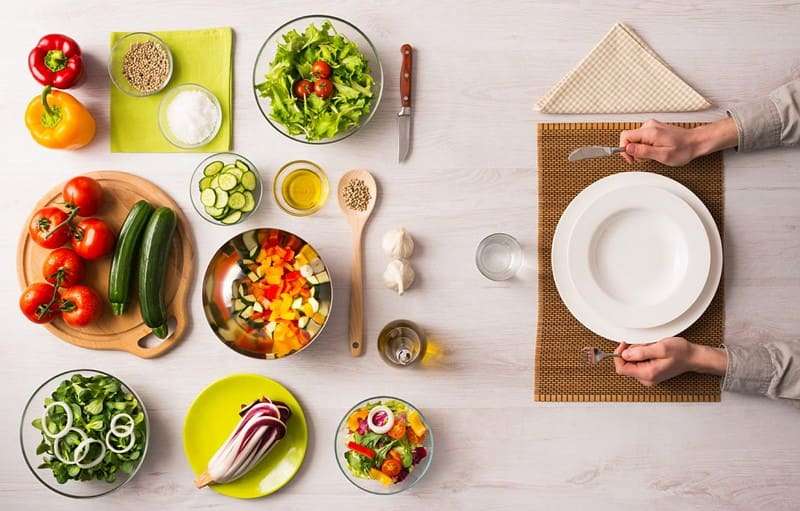
However, it must include protein, whole grains, and veggies along with a small amount of healthy fats. The goal is not to eat too little or too much but to find a portion that keeps you full and comfortable.
Special Considerations for Lunch Calories
Still, if you are curious to know the exact number of calories in my lunch, this section has got you covered. Review the listed table, divided based on gender, age, and activity level, and determine what amount suits you best:
| Group | Recommended Lunch Calories | Average Daily Calorie Needs | Ideal Nutrient Focus | Key Notes |
| Children (6–12 years) | 450–650 kcal | 1,400–1,800 kcal | Protein, calcium, vitamins | Encourage balanced meals that include fruits, vegetables, and dairy for optimal growth and learning. |
| Teenagers (13–19 years) | 600–1,000 kcal | 2,000–2,800 kcal | Protein, iron, fiber | Active teens or athletes may require higher lunch portions to support growth and maintain energy for sports. |
| Adults (20–59 years) | 500–700 kcal | 1,800–2,400 kcal | Protein, complex carbs, healthy fats | Maintain energy for work and metabolism; control portion sizes to achieve a balanced weight. |
| Seniors (60+ years) | 500–700 kcal | 1,800–2,200 kcal | Protein, fiber, calcium | Opt for softer meals that support digestion, heart, and bone health. |
| Athletes or Highly Active Individuals | 700–900 kcal | 2,800–3,500 kcal | Carbs, protein, electrolytes | Include complex carbohydrates and lean protein to sustain long periods of activity and support muscle recovery. |
| People with Specific Dietary Needs (e.g., diabetic, gluten-free, vegetarian) | 450–700 kcal | Varies by condition | Nutrient balance, controlled sugar, safe ingredients | Calorie intake depends on the condition; adjust carbs, fat, and sodium according to the health plan. |
Part 2. 5 Real-Life Factors Affecting Lunch Calorie Targets
When determining how many calories to eat for lunch, consider that various factors can influence your intake. A few of them are listed in this section to help you bypass them and live a balanced life:
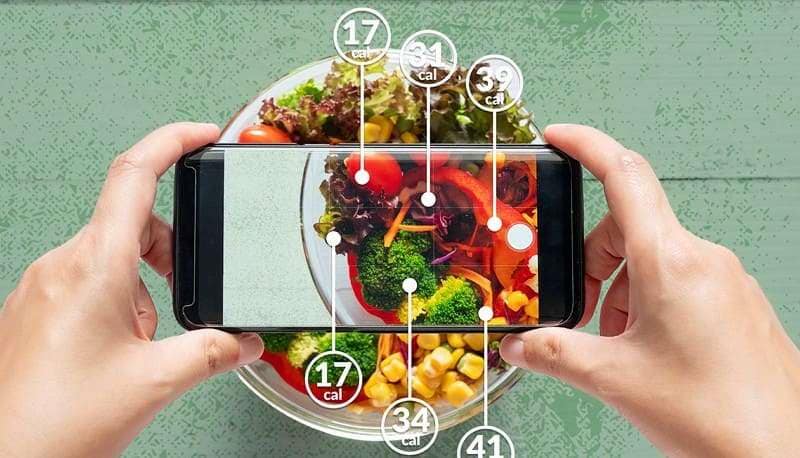
- Daily Activity Level: A person who engages in more physical activity requires more calories for energy. Someone with a desk job needs fewer calories because the body uses less fuel. For example, a delivery worker or athlete may consume 700–800 kcal at lunch, whereas an office worker may require around 500 kcal.
- Age and Metabolism: Younger people tend to burn more calories due to their faster metabolism. As age increases, the body's metabolism slows, resulting in a decrease in calorie needs. A 20-year-old student may require more calories at lunch than a 50-year-old teacher who spends most of the day sitting.
- Body Weight and Health Goals: To lose weight, you need to consume fewer calories; to gain weight, you need to increase your caloric intake. This shows that the body's size and goal shape the portion. For example, a salad with chicken is suitable for weight loss, while a rice bowl is more suitable for those who want to gain muscle.
- Work or Study Schedule: A long workday or school day needs a lunch that lasts longer. In contrast, a shorter day may require a lighter meal to avoid excess calories. For instance, a construction worker may need rice and meat, while someone with short work hours may prefer soup or a sandwich.
- Meal Timing and Portion Balance: A late breakfast or early dinner changes lunch needs. Balanced portions across the day help avoid hunger or overeating later. For example, if you eat breakfast at 11 a.m., a small wrap may be sufficient, but if dinner is at 9 p.m., a full plate with grains and protein is more suitable.
Part 3. How Many Calories Should My Lunch Be: Importance of Macronutrient Balance
As you seek to learn how many calories a lunch should be, know that macronutrients hold importance. A healthy lunch is not only about total calories but also about how those calories come from. Hence, maintaining the right balance keeps your body b and alert for the rest of the day, which is why this section highlights the recommended combinations you should try.
Recommended Macronutrient Balance for Lunch
| Macronutrient | Recommended Share of Lunch Calories | Main Function | Best Food Sources |
| Protein | 20–30% | Builds and repairs muscles | Chicken, fish, eggs, beans, tofu |
| Whole Grains (Carbohydrates) | 45–55% | Provides energy and fiber | Brown rice, quinoa, oats, whole-grain bread |
| Vegetables | 20–25% | Adds vitamins, minerals, and fiber | Leafy greens, carrots, broccoli, peppers |
| Healthy Fats | 20–30% | Supports brain and heart health | Olive oil, avocado, nuts, seeds |
Sample Lunch Combinations
| Combination Type | Example Plate | Why It Works |
| Lean Meat Option | Grilled chicken, brown rice, and steamed vegetables | Offers lean protein, complex carbs, and vitamins for steady energy. |
| Plant Protein Option | Lentil salad with quinoa and avocado | Gives plant-based protein, fiber, and healthy fats in one balanced meal. |
| Light Office Lunch | Tuna sandwich on whole-grain bread with cucumber slices | Easy to prepare and supports focus without feeling heavy. |
| Energy Boost Lunch | Beef stir-fry with rice and mixed vegetables | Higher in protein and carbs for active or long workdays. |
| Vegetarian Choice | Chickpea wrap with spinach and olive oil dressing | Combines protein, fiber, and good fats for fullness and heart health. |
Part 4. Top 5 Examples of Healthy Lunches by Calorie Count
Now, if you'd like to try any of the listed combinations, explore the recipes along with their estimated calorie ranges. Additionally, learn how to identify the best options as you discover the recommended number of calories for lunch.
1. Grilled Chicken with Brown Rice and Steamed Vegetables
This meal gives lean protein, fiber, and energy for a busy day. The chicken adds strength and fullness, while rice and vegetables provide steady energy and essential vitamins. Overall, it's the best option for weight management or light muscle support.
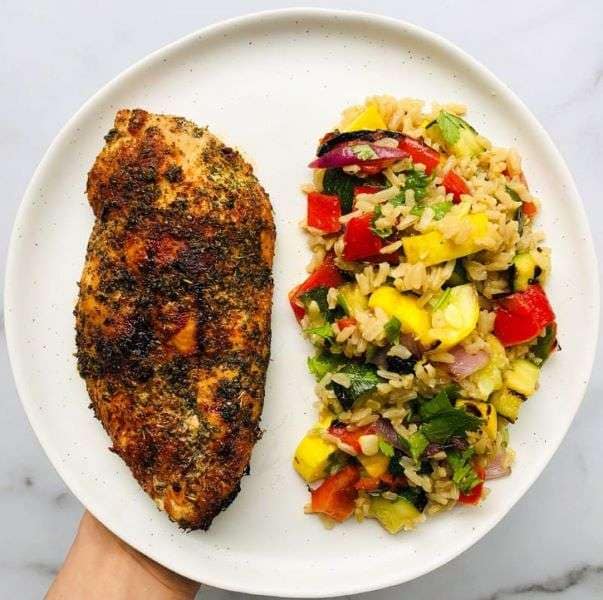
| Ingredient | Serving Size | Calories (Approx.) | Nutritional Value |
| Chicken Breast (Grilled) | 150 g | 250 kcal | Lean protein, low fat |
| Brown Rice (Cooked) | 1 cup | 220 kcal | Complex carbs, fiber |
| Mixed Vegetables (Steamed) | 1 cup | 80 kcal | Vitamins and minerals |
| Olive Oil (For Grilling) | 1 tsp | 40 kcal | Healthy fats |
| Total Estimated Calories | ≈550 kcal | ||
2. Lentil Salad with Quinoa and Avocado
Unlike other options, this recipe offers a complete plant-based protein source rich in fiber and iron. Lentils and quinoa help maintain steady energy levels, and avocado adds a smooth texture and healthy fats. Hence, it suits vegetarians or anyone who aims to get a light and satisfying lunch.

| Ingredient | Serving Size | Calories (Approx.) | Nutritional Value |
| Cooked Lentils | 1 cup | 230 kcal | Protein, fiber, and iron |
| Quinoa (Cooked) | ½ cup | 120 kcal | Complex carbs and amino acids |
| Avocado | ½ fruit | 120 kcal | Healthy monounsaturated fats |
| Spinach or Kale | 1 cup | 50 kcal | Vitamins and antioxidants |
| Total Estimated Calories | ≈520 kcal | ||
3. Tuna Sandwich with Cucumber Slices
This quick lunch is suitable for office workers or students who need steady focus and want to know how many calories they should be eating for lunch. It gives lean protein, complex carbs, and hydration from cucumber and tomatoes. Additionally, it keeps you full without heaviness during work hours.
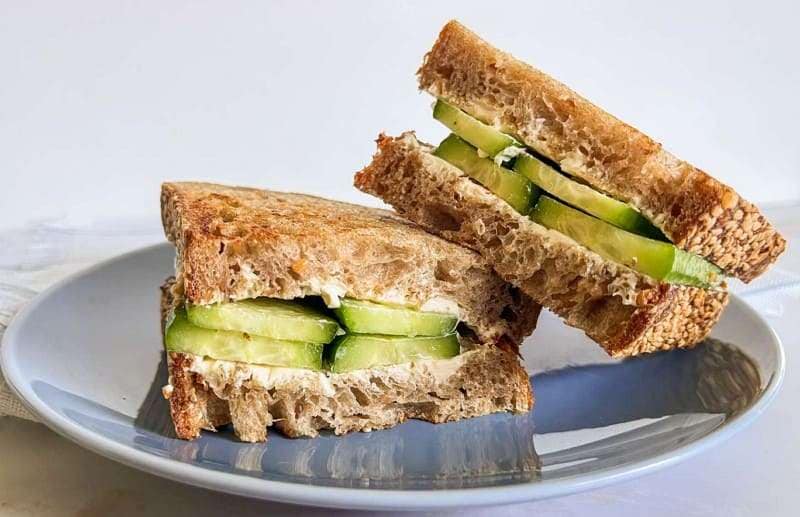
| Ingredient | Serving Size | Calories (Approx.) | Nutritional Value |
| Tuna (Canned in Water) | 1 can (100 g) | 150 kcal | Lean protein, omega-3 |
| Whole-Grain Bread | 2 slices | 180 kcal | Fiber and slow energy |
| Olive Oil or Yogurt (For Mix) | 1 tbsp | 90 kcal | Light healthy fat |
| Cucumber & Lettuce | ½ cup | 30 kcal | Hydration and vitamins |
| Total Estimated Calories | ≈450 kcal | ||
4. Beef Stir-Fry with Rice and Mixed Vegetables
It's a hearty recipe that gives the lasting power of physical work or gym days. Beef provides iron and protein, while rice and vegetables complete the plate with carbohydrates and essential nutrients. Overall, it's an ideal option for active individuals who require additional strength and energy.
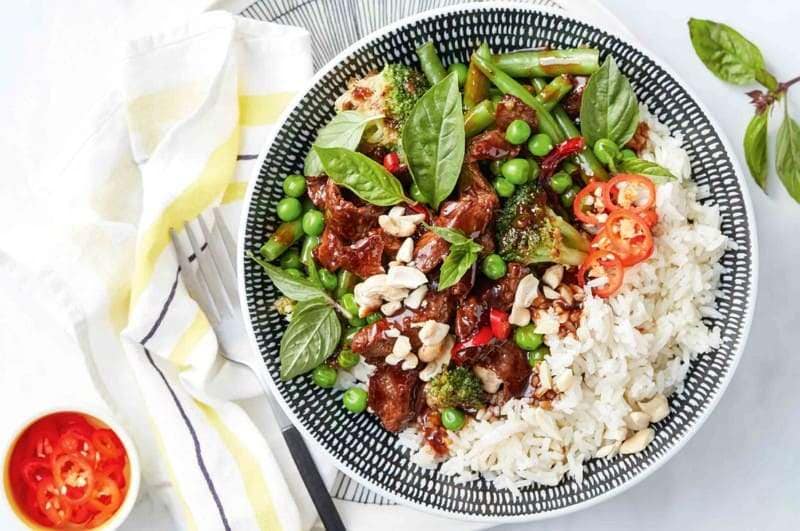
| Ingredient | Serving Size | Calories (Approx.) | Nutritional Value |
| Lean Beef | 120 g | 250 kcal | Protein and iron |
| Brown or White Rice | ¾ cup | 170 kcal | Complex carbs |
| Mixed Vegetables | 1 cup | 100 kcal | Fiber and vitamins |
| Olive Oil | 1 tbsp | 80 kcal | Heart-healthy fat |
| Total Estimated Calories | ≈650 kcal | ||
5. Chickpea Wrap with Spinach and Olive Oil Dressing
This simple wrap works well for plant-based diets or as a light lunch. Chickpeas give protein and fiber, while spinach and olive oil improve digestion and heart health. It offers freshness and balance in every bite that is hard to find in other recipes.
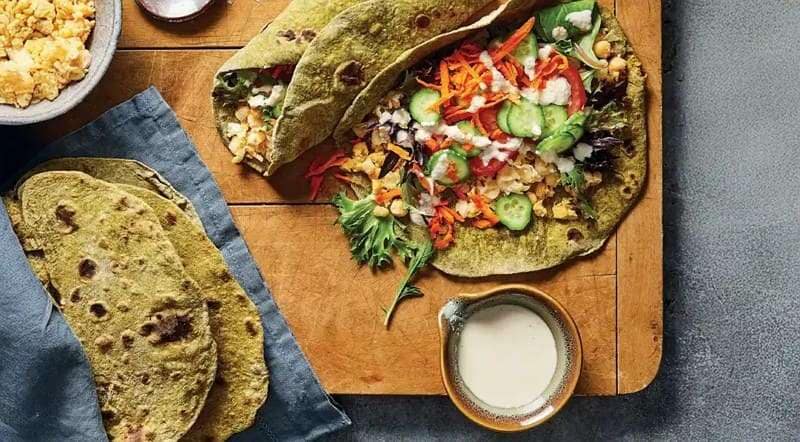
| Ingredient | Serving Size | Calories (Approx.) | Nutritional Value |
| Whole-Grain Wrap | 1 medium | 130 kcal | Fiber and steady carbs |
| Chickpeas (Boiled) | ½ cup | 130 kcal | Plant protein and fiber |
| Spinach & Peppers | 1 cup | 60 kcal | Vitamins and antioxidants |
| Olive Oil & Lemon Juice | 1 tbsp | 90 kcal | Healthy fat and flavor |
| Total Estimated Calories | ≈500 kcal | ||
Part 5. 5 Helpful Tips & Tricks for Building a Nutritious Lunch
When learning how many calories a lunch should be, though you know all the basics and recipes until now, here are some tips that can help:

- Choose Whole Foods Over Processed Ones: Opt for fresh fruits, vegetables, whole grains, and lean meats instead of packaged snacks. Whole foods give natural nutrients that keep the body b and full of energy.
- Add Protein for Lasting Energy: Protein keeps you full longer and supports muscle health. Try to incorporate eggs, beans, or tofu into your diet to stay alert throughout the day.
- Include Colorful Vegetables: Nutritionists believe that each color on the plate adds different vitamins and minerals. Therefore, fill half of your plate with greens, carrots, or peppers to support heat and skin health.
- Control Portions Without Skipping Taste: Use smaller plates or lunch boxes to manage food quantity. Additionally, add herbs, spices, and lemon for flavor so the meal stays tasty without excess fat or salt.
- Track and Adjust with CalBye App: Use the CalBye app to note what you eat each day and track your calorie goals. It helps you plan balanced lunches and stay close to your ideal calorie range. Moreover, the app includes AI capabilities and uses innovative algorithms to scan food. You can also chat with the AI to receive a detailed analysis of the food and track your calories.
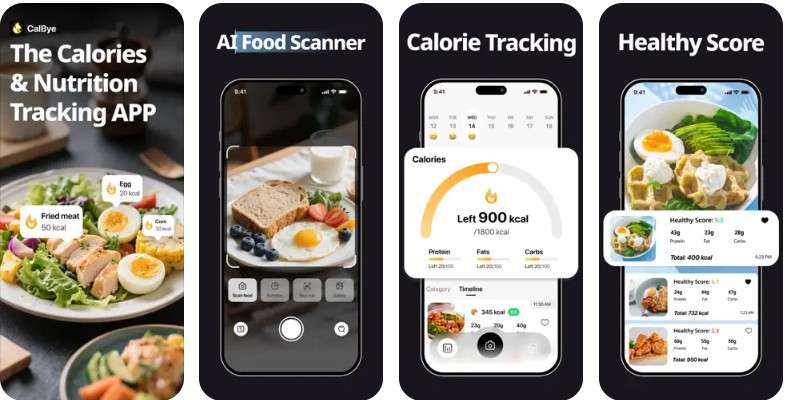
Additionally, it allows users to upload food images from the gallery for a quick scan or use the barcode scanner to get calorie details of packaged foods. After receiving a detailed report, you can also access dietary advice, alternative food options, and recipe combinations to try. You can even seamlessly add them to favorites and access them later, as the application's usage is simpler than that of other applications.
Key Features
- High Compatibility: The application is designed for Android and iOS users and can be easily used on their respective platforms to track calories.
- Water Intake Access: You can also use it to track your water intake and manage your weight in accordance with your goals.
- Track Achievements: The app features an achievements section that allows users to track their progress by categorizing meals and monitoring their calorie intake.
Track Lunch Calories with CalBye in 3 Simple Steps | Comprehensive Guide
After you know how many calories your lunch should be, learn how you can use this intuitive application to maintain a balanced lifestyle:
Step 1. Install CalBye and Start to Set Up
As you launch the innovative calorie tracker, select the "Scan Meal" button when you begin setting up the app.
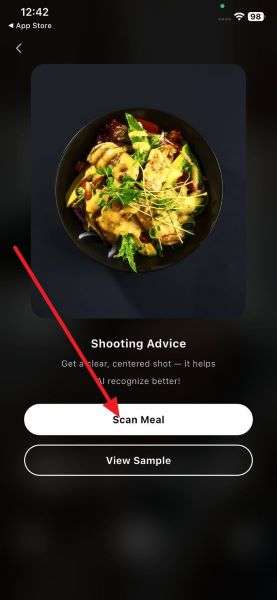
Step 2. Take Your Food Image to Get a Report
This will direct you to a new interface where you can choose to take a photo or import a food photo from the gallery if you seek to capture an image. Head to the "Scan Meal" feature and take the picture; after which, the AI will start the analysis.
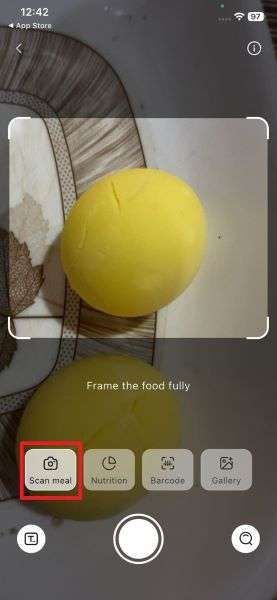
Step 3. Review the Report and Choose to Log It
Wait a while until you receive a detailed report, then press the "Log It" button after reviewing it.
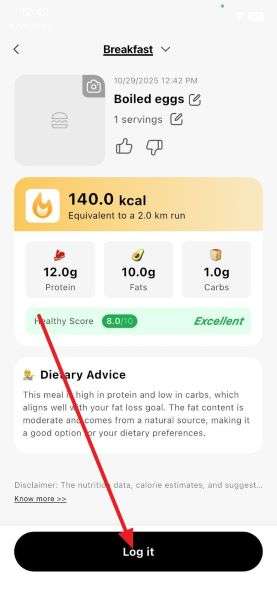
Conclusion
To wrap up, if you want to know how many calories a lunch should contain, this guide provides all the answers. From learning the importance of macronutrients to understanding the proper calorie intake based on gender, age, and activity level, review all the details. Additionally, as you try our given recipes, we suggest using CalBye to track calories and receive AI-powered results in just a few seconds.
FAQs
-
Why is lunch an essential meal of the day?
Lunch replenishes the body's energy after morning activities and prepares it for the rest of the day. A balanced lunch helps maintain focus, supports metabolism, and keeps blood sugar levels steady through the afternoon. -
Can skipping lunch affect health?
Yes, skipping lunch can cause fatigue, reduced concentration, and irritability. It may also lead to overeating later in the day, disrupting digestion and overall calorie balance. -
What happens if lunch is too heavy?
A heavy lunch can slow digestion and make you feel sluggish or sleepy. Additionally, it may cause bloating or discomfort, which can impact productivity and energy levels after eating.





